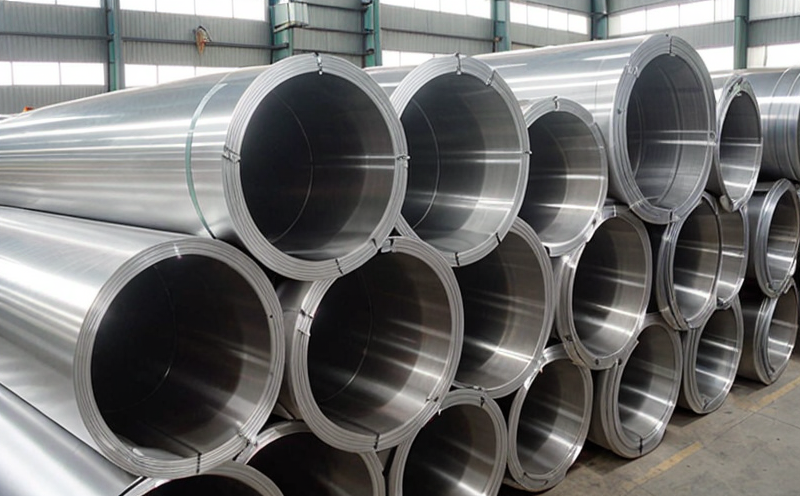ISO 22196 Antibacterial Activity Testing of Marine Surfaces
The ISO 22196 standard provides a method for determining the antibacterial activity of materials and coatings used in marine environments. This service ensures that products such as hull paints, deck surfaces, and other marine equipment possess effective resistance against bacterial contamination, which is crucial given the high salinity and temperature conditions often found at sea.
The testing process involves exposing a specimen to a standardized bacterial challenge under controlled conditions. The results are then evaluated based on the reduction in bacterial growth over time. This method helps manufacturers and quality managers ensure that their products meet regulatory requirements while also enhancing product performance for end-users.
Aluminium materials, which are commonly used in marine equipment due to their durability and corrosion resistance, present unique challenges during testing. The high salinity of seawater can accelerate the breakdown of coatings applied to aluminium surfaces, making it imperative to test these materials according to ISO 22196 for accurate results.
The testing protocol is stringent and involves several key steps:
- Specimen Preparation: Specimens are cut into standard sizes and shapes, typically 50 mm x 50 mm or similar dimensions. This ensures that the results can be compared across different materials.
- Bacterial Challenge: The specimens are exposed to a standardized bacterial strain (e.g., S. aureus or E. coli) in a controlled environment designed to mimic marine conditions, including temperature and salinity levels.
- Detection: After exposure, the reduction in bacterial count is measured using quantitative methods such as agar dilution or spectrophotometric assays.
- Reporting: Results are reported based on the percentage reduction in bacterial growth compared to a control sample. Compliance with ISO 22196 ensures that the antibacterial activity meets international standards for marine surfaces.
The use of this standard is particularly important for manufacturers and quality managers who need to ensure their products meet regulatory requirements while also enhancing product performance for end-users. The testing process provides a reliable measure of antibacterial effectiveness, which is critical in preventing biofouling and maintaining the structural integrity of marine equipment.
Benefits
The implementation of ISO 22196 Antibacterial Activity Testing for Marine Surfaces brings several advantages to manufacturers, quality managers, R&D engineers, and procurement teams:
- Regulatory Compliance: Ensures that products meet international standards, thereby reducing the risk of regulatory non-compliance.
- Enhanced Product Performance: By ensuring effective antibacterial activity, manufacturers can enhance the durability and longevity of their marine equipment.
- Better Decision-Making: Provides data-driven insights that help in selecting the most suitable materials for specific applications.
- Customer Satisfaction: Meeting international standards reassures customers about product reliability and safety.
- Innovation Support: Encourages R&D teams to innovate with confidence, knowing they meet rigorous testing criteria.
- Ethical Responsibility: Demonstrates a commitment to environmental sustainability by reducing the impact of biofouling on marine ecosystems.
These benefits contribute significantly to the reputation and success of companies operating in the marine sector. By adhering to ISO 22196, businesses can ensure they are delivering products that meet the highest international standards for antibacterial activity.
Quality and Reliability Assurance
The ISO 22196 standard plays a crucial role in ensuring the quality and reliability of marine equipment. By adhering to this standard, manufacturers can:
- Ensure Consistency: The standardized testing process ensures that all specimens are tested under identical conditions, leading to consistent results.
- Identify Weaknesses Early: Through rigorous testing, potential weaknesses in materials and coatings can be identified early in the development process.
- Promote Continuous Improvement: The data generated from these tests allows for continuous improvement in product design and manufacturing processes.
- Increase Customer Trust: Compliance with international standards builds trust among customers, who value products that meet global benchmarks.
The use of ISO 22196 also helps in maintaining a high level of quality and reliability across the supply chain. By ensuring that all components of marine equipment meet this standard, manufacturers can ensure that their final products are robust and reliable, even under challenging environmental conditions.
Use Cases and Application Examples
| Application | Description |
|---|---|
| Hull Paints | Testing ensures that the paint applied to ship hulls can effectively prevent bacterial growth, reducing biofouling and extending the life of the vessel. |
| Deck Surfaces | Evaluates the antibacterial properties of surfaces used on deck, ensuring they remain clean and hygienic in marine environments. |
| Marine Fencing | Tests the effectiveness of fencing materials against bacterial contamination, which is crucial for maintaining a healthy environment around docks and piers. |
| Cargo Containers | Evaluates the antibacterial properties of container surfaces to prevent the spread of bacteria during transport. |
| Marine Platforms | Ensures that platforms used for offshore operations have effective measures in place to prevent bacterial growth and contamination. |
| Cargo Handling Equipment | Evaluates the antibacterial properties of equipment used in cargo handling, ensuring they remain hygienic and safe for use. |
These examples illustrate the wide range of applications where ISO 22196 Antibacterial Activity Testing can be applied. By testing materials and coatings according to this standard, manufacturers can ensure that their products are effective in preventing bacterial contamination in marine environments.





